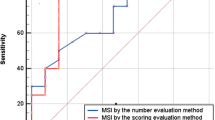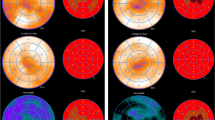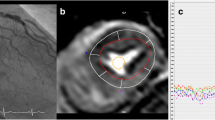Abstract
Selvester QRS scoring system has an advantage of being inexpensive and easily accessible for estimating myocardial infarct (MI) size. We assessed the correlation and agreement between QRS score and total perfusion deficit (TPD) calculated by quantitative gated single-photon emission computed tomography (QGS) in patients with prior anterior MI undergoing coronary intervention. Sixty-six patients with prior anterior MI and 66 age- and sex-matched control subjects were enrolled. QRS score was obtained using a 50-criteria and 31-point system. QRS score was significantly higher in patients with prior anterior MI than control subjects (12.8 ± 8.9 vs 1.1 ± 2.7 %, p < 0.001). In overall patients (n = 132), QRS score was correlated well with TPD (r = 0.81, p < 0.001). This good correlation was found even in patients with TPD ≤40 % (n = 126) or in patients with TPD ≤30 % (n = 117). In overall patients, MI size estimated by QRS score was 7.0 ± 8.8 %, which was significantly smaller than TPD, 11.4 ± 14.0 % (p < 0.001). Bland–Altman plot showed that there was an increasing difference between QRS score and TPD with increasing MI size. When Blant–Altman plots were applied to patients with TPD ≤40 % and further in patients with TPD ≤30 %, the difference between QRS score and TPD became smaller, and the agreement became better. In overall patients, QRS score was correlated well with QGS measurements, such as end-diastolic volume (r = 0.62, p < 0.001), end-systolic volume (r = 0.67, p < 0.001), or ejection fraction (r = −0.73, p < 0.001). Our results suggest that QRS score reflects TPD well in patients with prior anterior MI, whose TPD is less than approximately 30 % even in the coronary intervention era.





Similar content being viewed by others
References
Nishizaki F, Tomita H, Yokoyama H, Higuma T, Abe N, Suzuki A, Endo T, Tateyama S, Ishida Y, Osanai T, Okumura K (2013) Re-elevation of T-wave from day 2 to day 4 after successful percutaneous coronary intervention predicts chronic cardiac systolic dysfunction in patients with first anterior acute myocardial infarction. Heart Vessel 28:704–713
Palmeri ST, Harrison DG, Cobb FR, Morris KG, Harrell FE, Ideker RE, Selvester RH, Wagner GS (1982) QRS scoring system for assessing left ventricular function after myocardial infarction. N Engl J Med 306:4–9
Wagner GS, Freye CJ, Palmeri ST, Roark SF, Stack NC, Ideker RE, Harrell FE Jr, Selvester RH (1982) Evaluation of a QRS scoring system for estimating myocardial infarct size. I. Specificity and observer agreement. Circulation 65:342–347
Selvester RH, Wagner GS, Hindman NB (1985) The Selvester QRS scoring system for estimating myocardial infarct size. The development and application of the system. Arch Intern Med 145:1877–1881
Engblom H, Wagner GS, Setser RM, Selvester RH, Billgren T, Kasper JM, Maynard C, Pahlm O, Arheden H, White RD (2003) Quantitative clinical assessment of chronic anterior myocardial infarction with delayed enhancement magnetic resonance imaging and QRS scoring. Am Heart J 146:359–366
Geerse DA, Wu KC, Gorgels AP, Zimmet J, Wagner GS, Miller JM (2009) Comparison between contrast-enhanced magnetic resonance imaging and Selvester QRS scoring system in estimating changes in infarct size between the acute and chronic phases of myocardial infarction. Ann Noninvasive Electrocardiol 14:360–365
Ko T, Utanohara Y, Suzuki Y, Kurihara M, Iguchi N, Umemura J, Sumiyoshi T, Tomoike H (2016) A preliminary feasibility study of simultaneous dual-isotope imaging with a solid-state dedicated cardiac camera for evaluating myocardial perfusion and fatty acid metabolism. Heart Vessel 31:38–45
Slomka PJ, Fieno D, Thomson L, Friedman JD, Hayes SW, Germano G, Berman DS (2005) Automatic detection and size quantification of infarcts by myocardial perfusion SPECT: clinical validation by delayed-enhancement MRI. J Nucl Med 46:728–735
Berman DS, Kang X, Gransar H, Gerlach J, Friedman JD, Hayes SW, Thomson LE, Hachamovitch R, Shaw LJ, Slomka PJ, Yang LD, Germano G (2009) Quantitative assessment of myocardial perfusion abnormality on SPECT myocardial perfusion imaging is more reproducible than expert visual analysis. J Nucl Cardiol 16:45–53
Shiraishi J, Kohno Y, Sawada T, Hashimoto S, Ito D, Kimura M, Matsui A, Yokoi H, Arihara M, Irie H, Hyogo M, Shima T, Nakamura T, Matoba S, Yamada H, Matsumuro A, Shirayama T, Kitamura M, Furukawa K, Matsubara H (2013) Prognostic impact of pulse pressure at admission on in-hospital outcome after primary percutaneous coronary intervention for acute myocardial infarction. Heart Vessel 28:434–441
Abe D, Sato A, Hoshi T, Takeyasu N, Misaki M, Hayashi M, Aonuma K (2014) Initial culprit-only versus initial multivessel percutaneous coronary intervention in patients with ST-segment elevation myocardial infarction: results from the Ibaraki Cardiovascular Assessment Study registry. Heart Vessel 29:171–177
Zencirci E, Zencirci AE, Değirmencioğlu A, Karakuş G, Uğurlucan M, Özden K, Erdem A, Güllü AÜ, Ekmekçi A, Velibey Y, Erer HB, Çelik S, Akyol A (2015) The relationship between epicardial adipose tissue and ST-segment resolution in patients with acute ST-segment elevation myocardial infarction undergoing primary percutaneous coronary intervention. Heart Vessel 30:147–153
Abdelmoneim SS, Martinez MW, Mankad SV, Bernier M, Dhoble A, Pellikka PA, Chandrasekaran K, Oh JK, Mulvagh SL (2015) Resting qualitative and quantitative myocardial contrast echocardiography to predict cardiac events in patients with acute myocardial infarction and percutaneous revascularization. Heart Vessel 30:45–55
Verdoia M, Barbieri L, Schaffer A, Cassetti E, Marino P, Bellomo G, Sinigaglia F, De Luca G, Novara Atherosclerosis Study Group (NAS) (2015) Platelet-larger cell ratio and the risk of periprocedural myocardial infarction after percutaneous coronary revascularization. Heart Vessel 30:20–27
Kurisu S, Iwasaki T, Ikenaga H, Watanabe N, Higaki T, Shimonaga T, Ishibashi K, Mitsuba N, Dohi Y, Kihara Y (2014) Influence of left ventricular geometry on thallium-201 gated single-photon emission tomographic findings in patients with known or suspected coronary artery disease. Ann Nucl Med 28:120–127
Kurisu S, Iwasaki T, Abe N, Tamura M, Ikenaga H, Watanabe N, Higaki T, Shimonaga T, Ishibashi K, Dohi Y, Fukuda Y, Kihara Y (2015) Effects of myocardial perfusion abnormalities on the accuracy of left ventricular volume and ejection fraction measured by thallium-201 gated single-photon emission tomography: comparison with echocardiography as the reference standard. Nucl Med Commun 36:1127–1133
Bang LE, Ripa RS, Grande P, Kastrup J, Clemmensen PM, Wagner GS (2008) Comparison of infarct size changes with delayed contrast-enhanced magnetic resonance imaging and electrocardiogram QRS scoring during the 6 months after acutely reperfused myocardial infarction. J Electrocardiol 41:609–613
Rovers WC, van Boreen MC, Robinson M, Martin TN, Maynard C, Wagner GS, Gorgels AP (2009) Comparison of the correlation of the Selvester QRS scoring system with cardiac contrast-enhanced magnetic resonance imaging-measured acute myocardial infarct size in patients with and without thrombolytic therapy. J Electrocardiol 42:139–144
Engblom H, Arheden H, Foster JE, Martin TN (2007) Myocardial infarct quantification: is magnetic resonance imaging ready to serve as a gold standard for electrocardiography? J Electrocardiol 40:243–245
Carlsen EA, Bang LE, Ahtarovski KA, Engstrøm T, Køber L, Kelbaek H, Vejlstrup N, Jørgensen E, Helqvist S, Saunamäki K, Clemmensen P, Holmvang L, Wagner GS, Lønborg J (2012) Comparison of Selvester QRS score with magnetic resonance imaging measured infarct size in patients with ST elevation myocardial infarction. J Electrocardiol 45:414–419
Author information
Authors and Affiliations
Corresponding author
Ethics declarations
Conflict of interest
The authors declare that they have no conflict of interest.
Rights and permissions
About this article
Cite this article
Kurisu, S., Shimonaga, T., Ikenaga, H. et al. Selvester QRS score and total perfusion deficit calculated by quantitative gated single-photon emission computed tomography in patients with prior anterior myocardial infarction in the coronary intervention era. Heart Vessels 32, 369–375 (2017). https://doi.org/10.1007/s00380-016-0884-0
Received:
Accepted:
Published:
Issue Date:
DOI: https://doi.org/10.1007/s00380-016-0884-0




